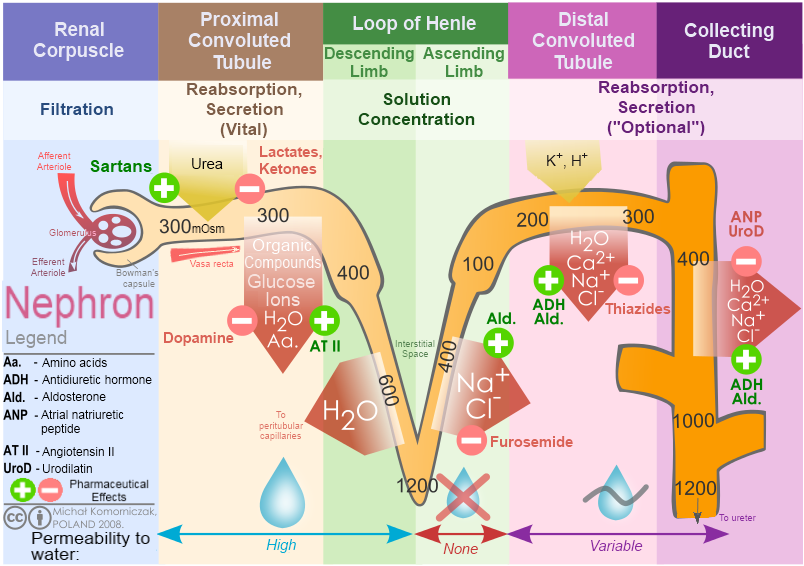Antibiotics and bacteria
(Should consult professional advice because every doctor has his/her own perspective regarding antibiotic use.)
 |
| Author: Kendrick Johnson |
1. Antibiotics and drug resistance
- mechanism: bacterial pump(1/10 of bac. genome coding for pumps); collateral damage caused by wide spectrum antibiotics and subsequent selection of resistant colonies
- mechanism: bacterial pump(1/10 of bac. genome coding for pumps); collateral damage caused by wide spectrum antibiotics and subsequent selection of resistant colonies
- hospital monitoring: Most bac. are sensitive to amikacin, but beware of renal toxicity); other indicators of resistance: ciprofloxacin, levofloxacin etc.
- example: E. coli resistance development(ampicillin-->cefazolin-->ceftriaxone-->carbapenem-->colistin)
2. Bacteria review
GPC(Staphylococcus, Streptococcus, Enterococcus)
Staphylococcus
- coagulase (+): S. aureus
- coagulase (-): other Staphylo
GPB(Listeria, Bacillus, Clostridium)
GNC(Neisseria)
GNB(Enterobacteriaceae, NFGNB, Haemophilus)
NFGNB(live on little amount of sugar)
- Pseudomonas
- Acinetobacter baumanii
- Stenotrophomonas maltophilia
- Burkholderia
- Moraxella catarrhalis
3. Antibiotics categories
- Main force: cell wall inhibitors
- Assistance: protein inhibitors
- Second line: quinolone, rifampin
- Killers: Daptomycin (sounds effective but cannot kill intracellular pathogens)
4. Drug of choice( Newer drug isn't always better _)
- Syphilis, Spirochetes, Strep. group A: Penicillin G
(cp. strep group B: http://emedicine.medscape.com/article/229091-treatment)
- MSSA cellulitis: Oxacillin
- Enteroccocus: resistant to all cepha, use Penicillin G or Ampicillin
- MRSA: Vancomycin (but Vanco has poor CNS penetration)
- Infective endocarditis: Penicillin G 3-4 MU IV Q4H +Gentamicin 1mg/kg Q8H for 4-6wks
Further reading: http://cid.oxfordjournals.org/content/49/2/320.full
- Uncomplicated sinusitis, pharyngitis, otitis media: Amoxicillin(250-1000mg PO Q8H)
- Neonatal E. Coli infection/Adult Listeria meningitis: Ampicillin(1-3g IV Q4H-Q6H for Listeria)
- Respiratory tract infection: AUGMENTIN(Amoxicillin +Clavulanate), UNASYN(Ampicillin +Sulbactam), sulbactam--> Acinetobacter baumannii
- Klebsiella pneumonia: Cephalosporins(3rd if community invasive infection) + aminoglycosides
- Enteric bacilli with ESBL: resistance to 3rd cephalosporins; use Imipenem or Meropenem, Ciprofloxacin
- Salmonella: Should not be treated with aminoglycosides, 1st- or 2nd- generation cephalosporins or imipenem, use 3rd cephalosporins, Quinolone, and TMP-SMZ, Ampicillin, Chloramphenicol if (S)
- Pseudomonas infection(HAP?): TAZOCIN
- Pseudomonas: aminoglycoside(UTI), Ceftazidime+aminoglycoside(pneumonia and/or bacteremia), ciprofloxacin/levofloxacin
- Stenotrophomonas infection: TMP-SMZ, TIMENTIN, Levofloxacin
(ticarcillin +clavulanate)
- Acinetobacter baumannii: ceftazidime, imipenem or meropenem; colistin+carbapenem or sulbactam
5. ß-Lactam antibiotics
- Penicillin, Cephem(Cephalosporin/Cephamycin), Monobactam, Carbapenem, ß-lactamase inhibitor
- Enteric bacilli with ESBL: resistance to 3rd cephalosporins; use Imipenem or Meropenem, Ciprofloxacin
- Salmonella: Should not be treated with aminoglycosides, 1st- or 2nd- generation cephalosporins or imipenem, use 3rd cephalosporins, Quinolone, and TMP-SMZ, Ampicillin, Chloramphenicol if (S)
- Pseudomonas infection(HAP?): TAZOCIN
- Pseudomonas: aminoglycoside(UTI), Ceftazidime+aminoglycoside(pneumonia and/or bacteremia), ciprofloxacin/levofloxacin
- Stenotrophomonas infection: TMP-SMZ, TIMENTIN, Levofloxacin
(ticarcillin +clavulanate)
- Acinetobacter baumannii: ceftazidime, imipenem or meropenem; colistin+carbapenem or sulbactam
5. ß-Lactam antibiotics
- Penicillin, Cephem(Cephalosporin/Cephamycin), Monobactam, Carbapenem, ß-lactamase inhibitor
Penicillins
- Recite!
Ampicillin + Sulbactam = Unasyn (MSSA, Acinetobacter, bacteroides)
Amoxicillin + Clavulanic acid = Augmentin
Ticarcillin + Clavulanic acid = Timentin
Piperacillin + Tazobactam = Tazocin
Cephems
-First-generation cephem
Cefazolin (IV)
Cephalexin (oral)
-Second-generation cephem
Cefuroxime (IV, oral)
Cefoxitin, cefmetazole (IV cephamycin)
-Third-generation cephem
Without antipseudomonal activity: Ceftazidime, Cefoperazone
With antipseudomonal activity: Cefotaxime, ceftriaxone (IV); Cefixime, cefpodoxime (oral)
-Fourth-generation cephem
Cefepime
Cefpirome
Carbapenems : for ESBL, anaerobics
- Imipenem
- Meropenem
- Ertapenem: NOT for pseudomonas, AB
Fluoroquinolones: CAN cover AB, Salmonella, Shigella, atypical, anaerobics, resistance strains, STD(gonorrhea)
- 2nd generation Ciprofloaxin (Cirpoxin): GNB, NFGNB
- 3rd generation Levofloxacin (Cravit), Moxifloxacin (Avelox)
Aminoglycosides: seldom used alone if G(+)
- Gentamycin
- Amikacin
- Recite!
Infective endocarditis: Penicillin G + gentamicin
Enterococcus infection: Ampicillin + gentamicin
Staphylococcus infection: Oxacillin + gentamicin/ Vancomycin + gentamicin
Macrolides: MRSA, S. pneumonia, atypical
- Erythromycin
- Clarithromycin
- Azithromycin
SMX-TMP
- simple UTI
- PCP
- salmonella; traveler's diarrhea
- Steno/Burkholderia/Chryseo
Tetracycline (Mycoplasma, Chlamydia, Rickettsia)
- Tetracycline: Q6H
Minocycline: Q12H
Doxycycline: Q24H
- Tigercycline
Others
- Metronidazole: amoeba, Clostridium difficle
- Clindamycin: for G(+), alternative
- Chloramphenicol
- Colistin: multiple drug resistant G(-)






